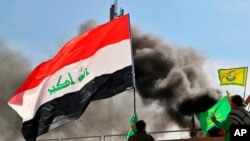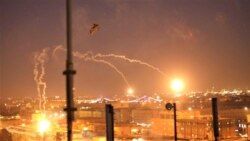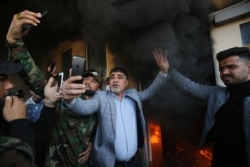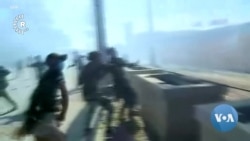Security forces at the U.S. Embassy in Iraq’s capital used tear gas Wednesday to disperse protesters led by pro-Iran militiamen as they gathered for a second day at the diplomatic site.
Some spent the night camped outside the embassy walls in Baghdad after a large crowd Tuesday breached the outer reaches of the compound and set several fires.
U.S. President Donald Trump said Tuesday he is holding Iran responsible for any damage or injuries at U.S. facilities.
“They will pay a very big price. This is not a warning. It is a threat,” Trump tweeted.
Speaking to reporters late Tuesday, Trump said he does not see the United States going to war with Iran.
“I don’t think Iran would want that to happen. It would go very quickly,” Trump added.
Iran’s Supreme Leader Ayatollah Ali Khamenei condemned U.S. actions in Iraq and Syria in his own Twitter comments Wednesday, and responded directly to Trump’s threats by saying, “You can’t do anything.”
“If you were logical — which you’re not — you’d see that your crimes in Iraq, Afghanistan ... have made nations hate you,” Khamenei wrote.
More US troops to Mideast
The U.S. Defense Department is sending an additional 750 troops to the Middle East in what Defense Secretary Mark Esper called “an appropriate and precautionary action.”
“We rely on host nation forces to assist in the protection of our personnel in country, and we call on the government of Iraq to fulfill its international responsibilities to do so,” he said.
Trump spoke Tuesday with Iraqi Prime Minister Adel Abdul Mahdi about the need to protect U.S. personnel and facilities in Iraq, and in his late-night comments to reporters he thanked the Iraqi government.
“They stepped up very nicely,” Trump said.
Tuesday’s incident involved the pro-Iranian protesters using battering rams to smash through a steel door at a visitors center, setting fires and burning a security post before Iraqi security forces drove them back with tear gas and stun grenades. The embassy building itself was not damaged, and none of the crowd entered.
Embassy safe
The State Department said all U.S. personnel were safe and there were no plans to evacuate anyone.
Secretary of State Mike Pompeo tweeted that terrorists orchestrated the attack. He named Kataeb Hezbollah militia commander Abu Mahdi al Muhandis along with Qays al-Khazali, Hadi al-Amari, and Faleh al-Fayyad and posted a picture of all four outside the embassy.
Pompeo stressed that the attack “should not be confused with the legitimate efforts of Iraqi protesters who have been in the streets since October, working for the people of Iraq to end the corruption exported there by the Iranian regime.”
WATCH: Protesters Storm US Embassy in Iraq
US airstrikes anger Iraq
The incident Tuesday came in response to U.S. airstrikes Sunday targeting weapons storage facilities and command centers of the Iranian-backed Kataeb Hezbollah in Iraq and eastern Syria. Those strikes killed at least 25 people and wounded dozens.
U.S. officials say the airstrikes were in response to a rocket attack on an Iraqi military base last week that killed a U.S. defense contractor, and that evidence left no doubt Kataeb Hezbollah was responsible.
Kataeb Hezbollah, part of the state-sanctioned militias operating in Iraq known as the Popular Mobilization Forces (PMF), has denied responsibility for the Friday attack.
Iraq says the U.S. airstrikes were a “flagrant violation” of its sovereignty, as well as of the rules governing the “goals and principles” of the U.S.-led coalition in Iraq to fight and defeat the Islamic State terror group.
US blames Iraq
U.S. officials brushed aside such criticism and instead placed blame on Iraq for allowing Iranian proxies to operate at will inside their country despite 11 such attacks on U.S. and coalition forces in the past two months.
“We have warned the Iraqi government many times, and we’ve shared information with them to try to work with them to try to carry out their responsibility to protect us as their invited guests,” a senior U.S. official said. “They have not taken the appropriate steps.”
Since May, the United States has sent an additional 14,000 forces to the Middle East, along with air and missile defense systems and additional reconnaissance capabilities, in response to what officials see as a growing threat from Iran and its proxies.















